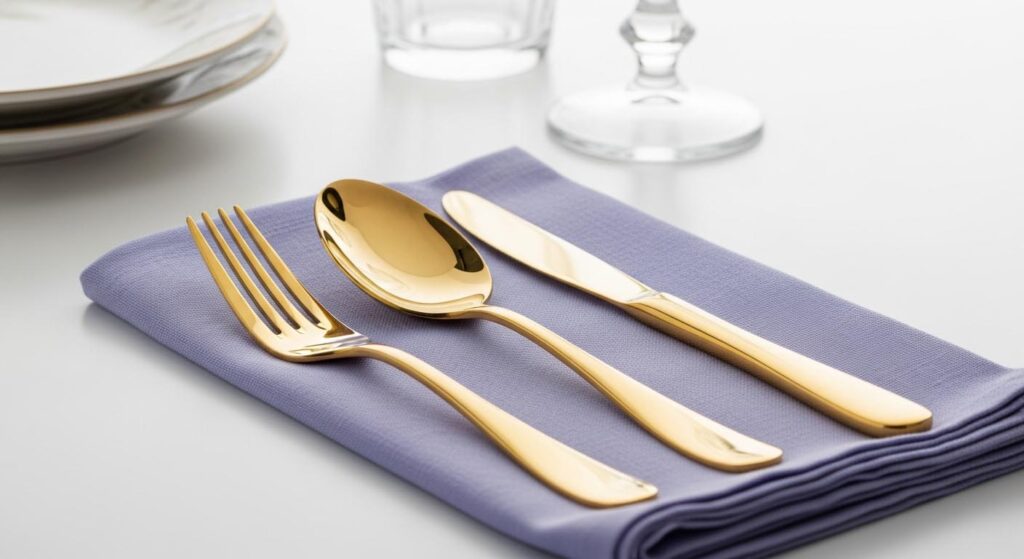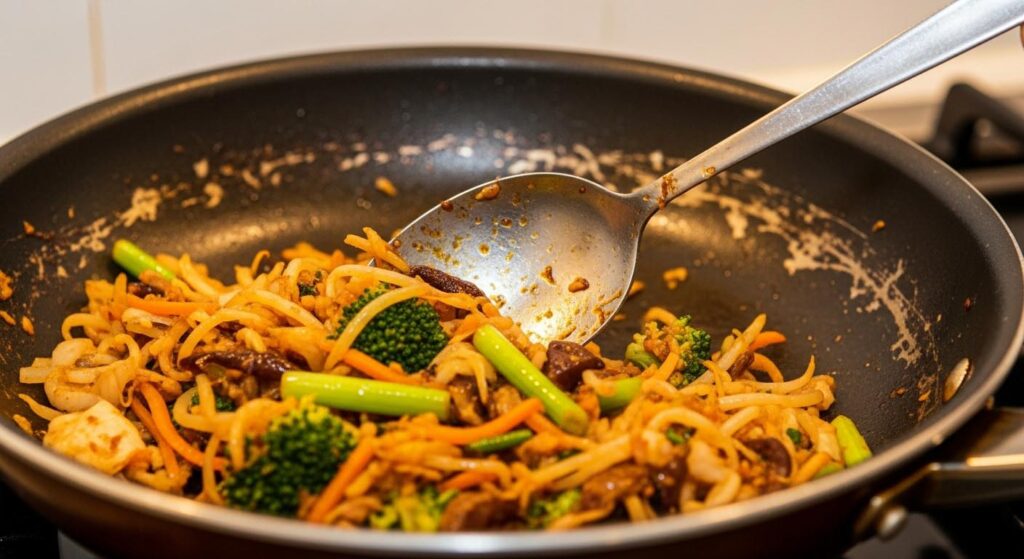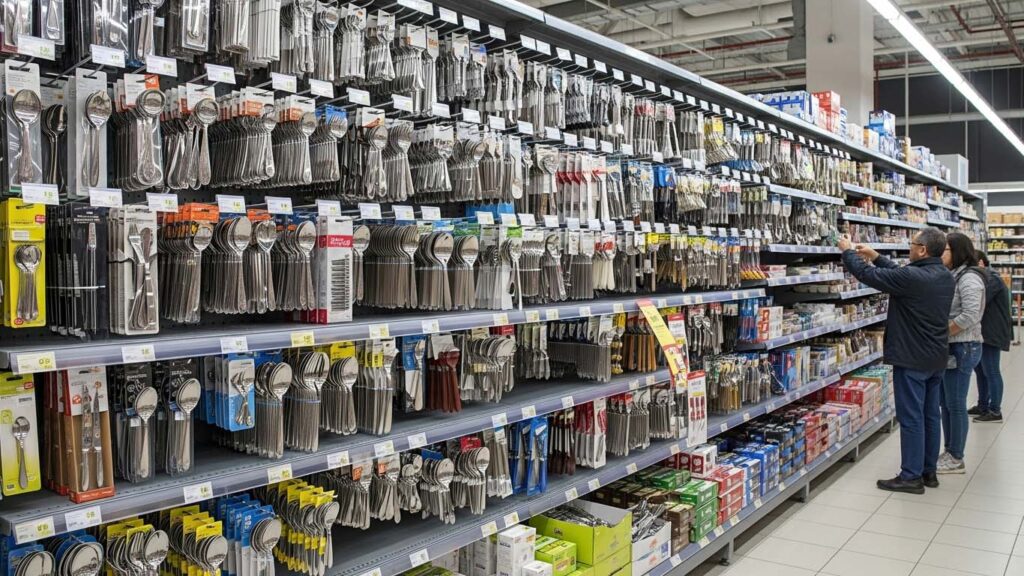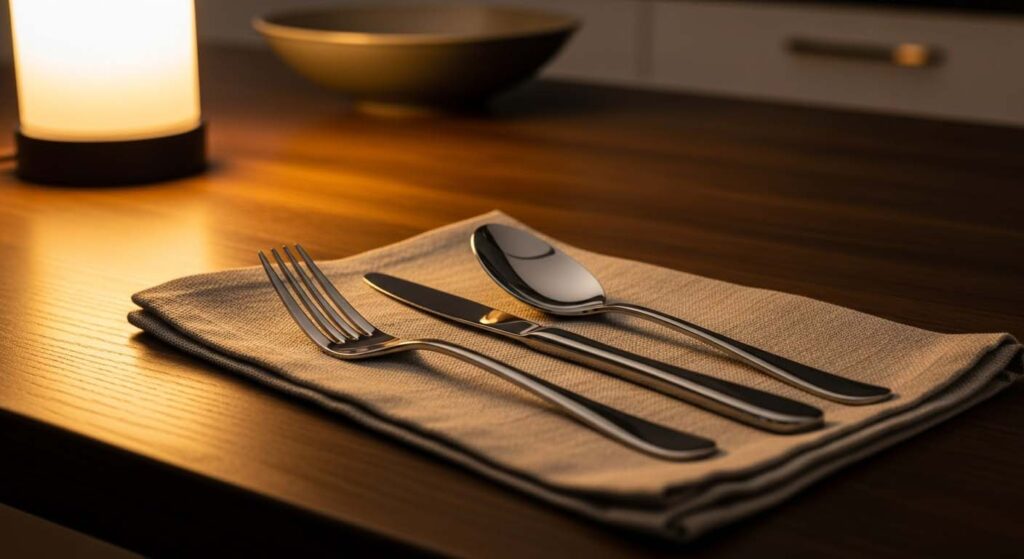Why are most cutlery made of metal?
You use metal cutlery every day without a second thought. But with options like wood and plastic available, you might wonder why this one material has dominated our dining tables for centuries.
Metal, specifically stainless steel, is the standard for cutlery because it offers an unmatched combination of durability, hygiene, and reusability. It is strong enough for any food, is non-porous and easy to sterilize, and does not retain flavors or odors.

As a manufacturer, the choice of material is the foundation of every product we create. When I work with expert buyers like Jacky, who sources for major brands, our conversations always center on the performance characteristics that only metal can provide. While wood and plastics have their niche uses, they simply can't compete with metal for the daily demands of a home or a busy restaurant. Let's explore why metal has earned its place as the undisputed king of cutlery and why that isn't likely to change anytime soon.
What are the disadvantages of metal cutlery?
You love your durable metal cutlery, but notice it can be heavy or scratch non-stick pans. You worry about these drawbacks and whether there are better alternatives for certain situations.
Metal cutlery's main disadvantages are its potential to scratch delicate surfaces like non-stick cookware, the subtle metallic taste some people perceive with lower-quality steel, and its thermal conductivity, meaning it can get hot in soups or tea.

While metal is the best overall choice, it's not perfect for every single task. Acknowledging its few drawbacks is important for using it correctly. In my factory, we design our products to minimize these issues, but they are inherent properties of the material itself. Acknowledging them helps my clients make the best choices for their specific needs.
Key Considerations
- Surface Damage: Metal is hard. This strength is a benefit, but it also means it can easily scratch softer materials. This is most obvious with non-stick pans, where a metal utensil can scrape off the delicate coating. It can also cause light marks on some softer ceramic plates over time. While good design with smooth, polished edges helps reduce this, the risk always remains.
- Thermal Conductivity1: Metal is an excellent conductor of heat2. If you leave a metal spoon in a hot bowl of soup or a cup of tea, the handle will quickly become hot to the touch. This is a basic law of physics. It is a minor inconvenience that materials like wood or plastic do not share.
- Potential for Metallic Taste: This is a valid concern, but it is almost always linked to the quality of the material. Low-grade stainless steel can sometimes have a slight reaction with highly acidic foods, which can produce a faint metallic flavor. This is why professional buyers insist on high-grade 18/8 or 18/10 stainless steel. The nickel in the alloy helps make the steel more inert, preventing this issue entirely.
What is the most common material for cutlery?
When you shop for cutlery, you are faced with many choices. The sheer number of options is overwhelming, leaving you unsure of what the true industry standard is for quality and reliability.
The most common material for modern, reusable cutlery is, without a doubt, stainless steel. Grades like 18/103, 18/8, and 18/0 are used globally for everything from high-end restaurant flatware to everyday household utensils.

Stainless steel absolutely dominates the cutlery market, and for very good reason. It simply hits the sweet spot between performance, cost, and aesthetics. My entire business, and indeed the entire global industry, is built around this remarkable material. To understand why it's so popular, it helps to compare it directly to the alternatives. For professional kitchens and homes alike, the choice becomes very clear.
| Material | Pros | Cons |
|---|---|---|
| Stainless Steel | Durable, Hygienic, Reusable, Affordable, Non-porous | Can scratch surfaces, Can be heavy |
| Plastic | Lightweight, Cheap, Colorful | Breaks easily, Stains, Not heat resistant, Bad for environment |
| Wood/Bamboo | Lightweight, Natural look, Won't scratch pans | Porous (can harbor bacteria), Stains, Requires special care |
| Sterling Silver | Beautiful, Valuable | Very expensive, Tarnishes easily, Soft (bends easily) |
As you can see, stainless steel provides the durability and hygiene of precious metals like silver but without the extreme cost or high maintenance. It completely avoids the disposability issues of plastic and the potential hygiene problems of porous wood. It is the commonsense choice that balances every important factor.
Is stainless steel 100% non-toxic?
You hear stories about chemicals leaching from cookware and plastics. This makes you second-guess even trusted materials like stainless steel, worrying about your family's long-term health and safety.
Yes, food-grade stainless steel is considered one of the safest and most non-toxic materials for cutlery. It is engineered to be stable and non-reactive, and it does not leach harmful chemicals into your food, even with heat or acidic ingredients.

The safety of our products is the most important promise I make to my clients. The answer here is an absolute yes. When you choose quality stainless steel, you are choosing one of the most trusted food-contact materials in the world. Its safety is not an opinion; it's proven by decades of use in homes, restaurants, and even sterile medical environments.
Why It's So Safe
The term "food-grade4" is key. It means the steel, particularly grades like 18/8 and 18/10, is specifically manufactured for this purpose. The elements within it—iron, chromium, and nickel—are locked together in a very stable crystal structure. This structure makes the metal "inert," which means it doesn't react with the food it touches.
The most common question is about nickel allergies. It's true that a small part of the population is sensitive to nickel. However, the amount of nickel that could ever leach from high-quality 18/10 stainless is tiny, far below the level that would cause a reaction in most individuals. For those with a diagnosed, extreme sensitivity, 18/0 stainless steel, which contains no nickel, is a perfect alternative. For everyone else, stainless steel is a completely harmless and reliable choice.
How long does stainless steel cutlery last?
You're buying a new set of cutlery and view it as a major purchase. You need to know if it's something that will last just a few years or if it is a true lifetime investment.
A well-made set of stainless steel cutlery can easily last a lifetime and can even be passed down for generations. Its fundamental strength prevents it from breaking or bending with normal use, and its corrosion resistance ensures it won't degrade over time.

Stainless steel is not a disposable product. When a client like Jacky places a large order for a hotel chain, he is planning for the long term. He expects the cutlery to endure thousands of meals and dishwasher cycles for years on end without needing replacement. Good stainless steel is built to meet that expectation.
Durability by Design
The physical properties of steel give it immense strength. It simply does not snap, crack, or break under the force of normal dining. Forged flatware, which starts as a solid bar of steel that is heated and hammered into shape, is even more robust and virtually indestructible. Unlike plastic which becomes brittle with age or wood that can split or rot, stainless steel's core properties do not change over the decades. The finish might develop a gentle "patina" of very fine scratches from years of use, but the fork or spoon itself will remain as strong and safe as the day it was made.
When I sell a high-quality 18/10 set, I frame it as a one-time purchase. It costs more upfront than a cheap alternative, but because it will likely never need to be replaced, its lifetime value is far greater. It is a true investment in quality.
Conclusion
Metal, especially stainless steel, is the top choice for cutlery because it perfectly balances immense durability, hygiene, safety, and longevity, making it the ideal material for daily use.
-
Understanding thermal conductivity is crucial for various applications in engineering and materials science. ↩
-
Explore the properties of metals that make them superior heat conductors, essential for many industrial applications. ↩
-
Learn about the significance of 18/10 stainless steel in cutlery, which offers superior quality and resistance to rust. ↩
-
Understanding food-grade steel is essential for ensuring safety and quality in food preparation and storage. ↩
